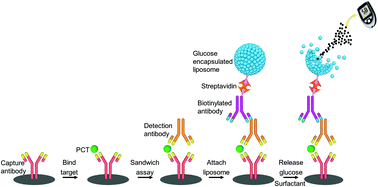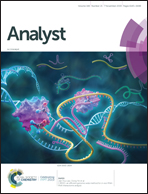The use of a personal glucose meter for detecting procalcitonin through glucose encapsulated within liposomes†
Abstract
Herein, a glucose meter-based immunosensing platform is developed that allows the quantification of procalcitonin (PCT) in whole blood samples. PCT is a biomarker for sepsis and its early detection would improve the safety of the patient, as the diagnostic process will be easier and faster. The method employs liposomes with encapsulated glucose as a signal generation tag, which are then used in a sandwich immunoassay by conjugating an antibody to the liposome. The optimal liposomes’ size and concentration of encapsulated glucose is determined experimentally to be 200 nm and 27.8 mM, respectively. Upon the addition of a surfactant (Triton X-100), the glucose is released and a signal is detected with a personal glucose meter (PGM). This signal is directly proportional to the concentration of the PCT in the sample. The dynamic range of the assay developed was 0.153–15.38 nM, and could allow the detection of PCT as low as 0.15 nM. The assay showed a high selectivity toward PCT against other proteins such as C-reactive protein and human serum albumin and good reproducibility. This assay was able to quantitatively determine the amount of PCT in whole blood samples at clinically-relevant concentrations.

- This article is part of the themed collection: Versatile Electrochemical Approaches


 Please wait while we load your content...
Please wait while we load your content...